
views
Tackling Stains
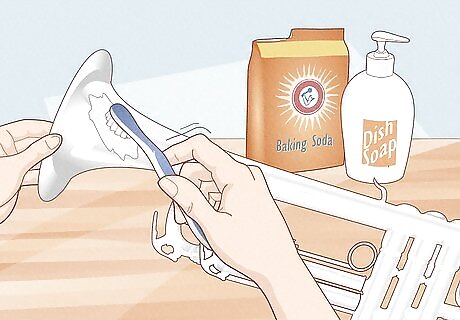
Mix equal parts liquid dish soap and baking soda for simple stains. Dab a bit of the paste onto a nylon scrubbie or an old toothbrush. Gently scrub the stain along the grain of the stainless steel.

Use vinegar for stronger stains. If the baking soda paste doesn’t work, dab a soft brush in undiluted vinegar. Scrub gently with the grain of the stainless steel. Wipe the vinegar away with a dry cloth. Alternately, fill a spray bottle with some vinegar and spray it on the stain, then use your brush or a paper towel to wipe the stain away.
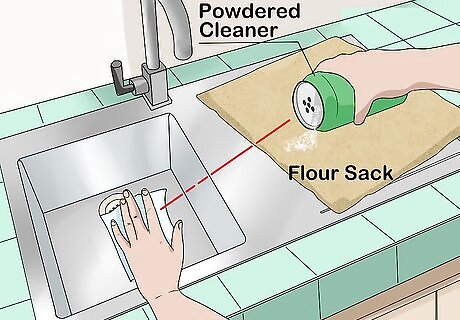
Use a flour sack and powdered cleaner to get rid of sink stains. Dampen a corner of an empty flour sack. Sprinkle a powdered cleaner (like Comet or Bon Ami) over it. Rub it onto the stain in a circular motion. Wet another corner of the sack, then wipe the stain in the opposite direction. Finally, wipe the entire area you cleaned with wax paper.
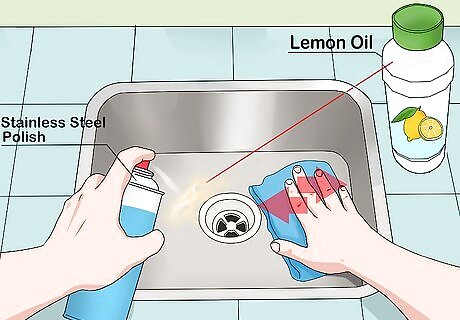
Buff your stainless steel sink or appliances after cleaning. Use a stainless steel polish, lemon oil, or a silicone-based spray to maintain the finish. While the specific directions will vary depending on the product you use, you can generally apply a bit of the buffing agent to a clean cloth, then wipe back and forth along the direction of the stainless steel grain. Instead of a store-bought product, you could also use a mineral oil such as olive oil. Just dab a cloth or paper towel in a bit of the oil and wipe along the direction of the grain.
Removing Rust
Make a paste of baking soda and water. If your stainless steel has rust spots, don’t fret! They’re easy to remove. Mix 1 tablespoon (14.4 g) of baking soda into 2 cups (470 mL) of water.
Scrub the rust away with a toothbrush dipped in the paste. Pick a clean toothbrush with soft bristles. You won’t be able to use it on your teeth again, so choose an old one. Dip the bristles in the baking soda paste, then use the brush to scrub the rust spots.
Rinse the paste away. Rinse away the baking soda with warm water. Then, wipe the stainless steel with a paper towel. The rust should be gone!
Adhering to General Rules
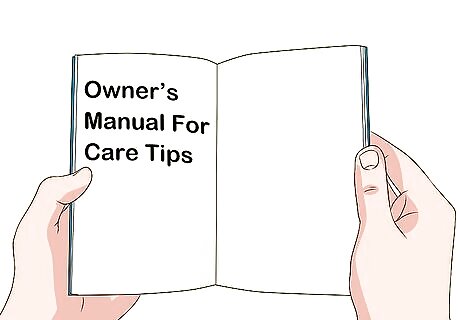
Check your owner’s manual for care tips. Your owner’s manual might have specific tips or advice about how to best remove stains from stainless steel. With these directions in hand, you’ll be able to remove stains in the best possible way.
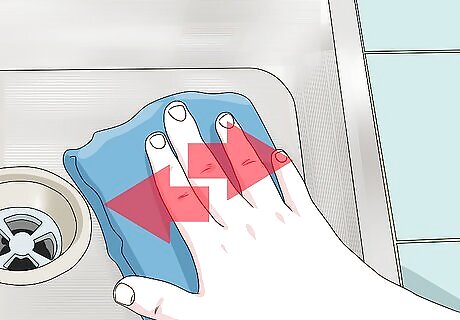
Wipe in the direction of the stainless steel grain. To identify the direction of the grain in your stainless steel object or appliance, look closely at it. You’ll notice the metal is actually organized into thin strips that all point in one direction. Unless otherwise noted, clean along the grain of the stainless steel.
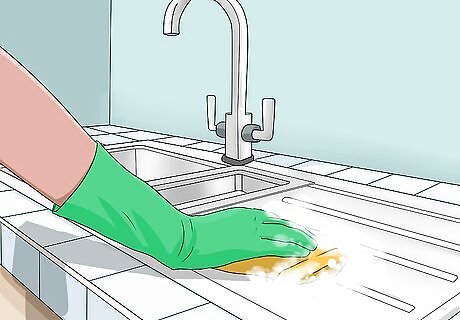
Wipe down stainless steel appliances every time you do the dishes. Use a damp, soapy washcloth to wipe the surface along the grain. Rinse the washcloth with clean water, then wipe the stainless steel appliance again. Wipe it with a dry cloth to prevent water spots.
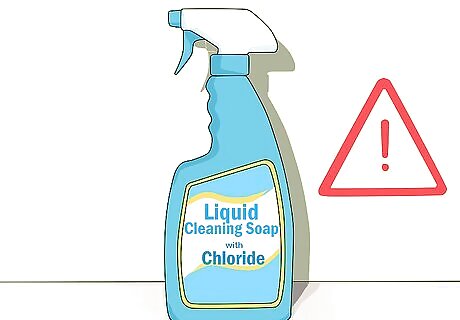
Avoid using cleaning products that might damage your stainless steel. Cleaners containing chlorides (including iodine, bromine, chlorine, and fluorine) can cause pitting and damage your stainless steel. Alcohol, ammonia, or mineral spirits can also hurt the protective layer over the steel surface. Finally, abrasive steel wool or steel brushes can scratch the stainless steel surface and encourage rust.
Cleaning Your Stainless Steel
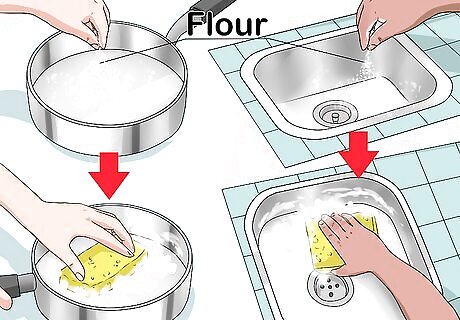
Sprinkle flour on stainless steel pots, pans, and sinks. Clean as much of the surface as possible using a sponge dipped in hot, soapy water. When the stainless steel is dry, sprinkle flour over it. Use a cloth or paper towel to buff the flour into the metal. This is great for removing bits of residual grime and dirt.
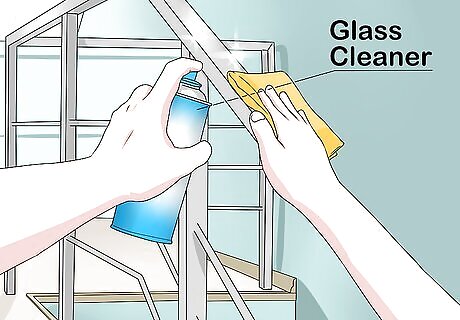
Use glass cleaner to remove fingerprints. Spray the glass cleaner liberally over the surface of the stainless steel, then use a clean cloth to wipe it down. This technique works best for wiping away fingerprints. You can also make your own glass cleaner. Get a ½ gallon (1.9 L) container and add 1 cup (240 mL) of high-proof alcohol and ⁄4 cup (59 mL) of white vinegar. Fill the rest of the container with water, then transfer the mixture to a spray bottle.
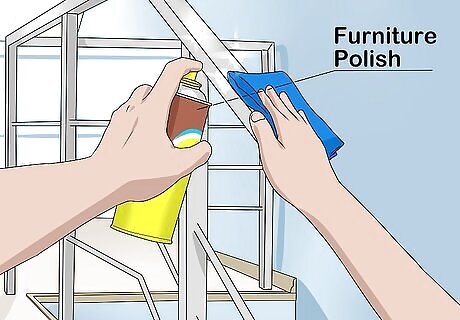
Add shine with furniture polish. Furniture polish can be used as an alternative to glass cleaner. Just spray a bit of the furniture polish on a clean cloth and wipe the surface of the stainless steel with it.

Use club soda on appliances. If you’re cleaning an appliance, fill a spray bottle with club soda and spray the stainless steel surface. Wipe along the grain of the stainless steel until it shines. If you’re cleaning a stainless steel sink, place the stopper in the bottom and fill it with club soda until the bottom is covered. Use a clean cloth to scrub the sides and bottom of the sink with circular motions, dipping your cloth in the club soda “puddle” as needed.










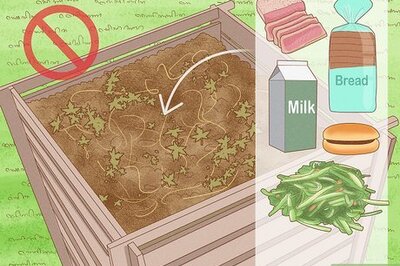



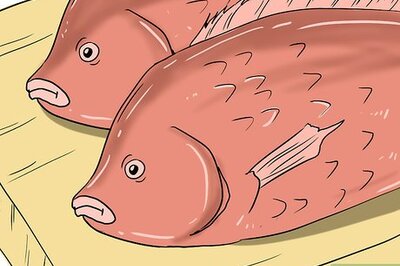




Comments
0 comment